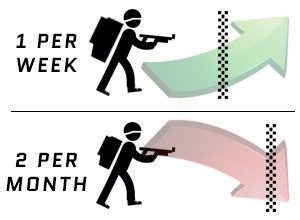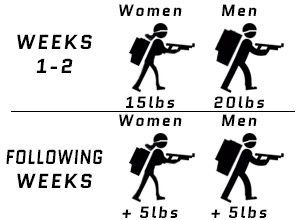
Rucking (jogging/marching with weighted backpack) is one of the most underrated methods of training. This training style was born out of necessity in the military because soldiers are required to carry large amounts of gear for extended periods of time. So training under a weighted ruck to prepare makes sense. With almost a million Iraq and Afghanistan veterans returning from the decades-long conflict, this training style has gained popularity in the civilian world.
Most are unaware that rucking is not just for the military. This training also has a practical application for first responders. Since firefighters have to run up multiple flights of stairs in bunker gear, and EMT/paramedics needs to carry first-in bags, they can also benefit from this type of training. The more conditioned your body is to carrying weight, the less taxing the stress of the weight is on your body. This ultimately means more air in your tank and an increased energy reserve to help your team.
Rucking Tips
Overtraining or carrying too much weight too quickly can lead to knee, back, and hip injuries. It is important to start slow to assess where you are. The recommended weight to start with is 15-20 lbs. Here are some other tips to consider to help avoid injury:
- Secure the weight in your ruck so it doesn’t move while you are in motion. This can be done through straps or by using other items in your ruck to keep the weight stable.
- Keep your ruck close to your body and high on your back. You want to keep the ruck secure. Don’t be afraid to tighten your shoulder straps.
- Stay hydrated by keeping an electrolyte filled water bladder in your ruck.
- For heavier loads, sternum straps help disperse the weight across your chest.
- For heavier loads, hip belts will allow the weight to not only fit more comfortably on your body, but it will also disperse the weight of the load.
- Proper shoes, socks, and breathable clothing will decrease the amount of moisture on your body and prevent friction. This combination will help to avoid chafing and blisters.
How to Improve Your Weight Carrying Ability
It’s pretty intuitive to assume that physical endurance will take a hit when moving with weight, but what does the science say?
 In a 2012 review of studies assessing physical training on rucking in the Journal of Strength and Conditioning Research, improvements in physical conditioning occurred when weight and distance increased over time as a part of a consistent training plan. In terms of terrain, weight, and distance, subjects improved regardless of their different training strategies. However, the group that improved the most (measured by march tests) was the group that moved heavier loads over shorter distances (compared to those who carried lighter loads over longer distances). In addition, the groups that rucked at least one session a week, compared to twice a month, experienced greater improvement.
In a 2012 review of studies assessing physical training on rucking in the Journal of Strength and Conditioning Research, improvements in physical conditioning occurred when weight and distance increased over time as a part of a consistent training plan. In terms of terrain, weight, and distance, subjects improved regardless of their different training strategies. However, the group that improved the most (measured by march tests) was the group that moved heavier loads over shorter distances (compared to those who carried lighter loads over longer distances). In addition, the groups that rucked at least one session a week, compared to twice a month, experienced greater improvement.
Training Plans
This research suggests that most forms of ruck training will enhance your endurance under a weighted load. However, to really optimize your training, start by carrying heavier loads over shorter distances, and keep in mind that consistency is key.
 With any training program, start out slow and let your body adjust to the feeling of carrying extra weight. Start with 15 lbs (female)/20 lbs (male), and try one 1-2 mile session during your first and second week (which should also include stretching and cross-training). For the next few weeks, try two sessions each week, increasing the weight by 5-10 pounds, based on how your body responded in weeks one and two. In time, depending on your goals and if you feel comfortable, gradually increase your pace, distance, and the weight, being sure to listen to your body.
With any training program, start out slow and let your body adjust to the feeling of carrying extra weight. Start with 15 lbs (female)/20 lbs (male), and try one 1-2 mile session during your first and second week (which should also include stretching and cross-training). For the next few weeks, try two sessions each week, increasing the weight by 5-10 pounds, based on how your body responded in weeks one and two. In time, depending on your goals and if you feel comfortable, gradually increase your pace, distance, and the weight, being sure to listen to your body.
All in all, the benefits of ruck training are well worth the effort, and if you are looking for company, there are rucking communities out there that have weekly and monthly organized rucks. Just remember, if it is a new activity, take it slow and listen to your body.
Disclaimer: The content in this article is the opinion of the writer and does not necessarily reflect the policies or opinions of US Patriot Tactical.





